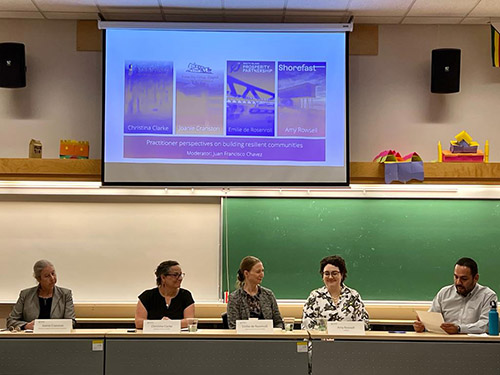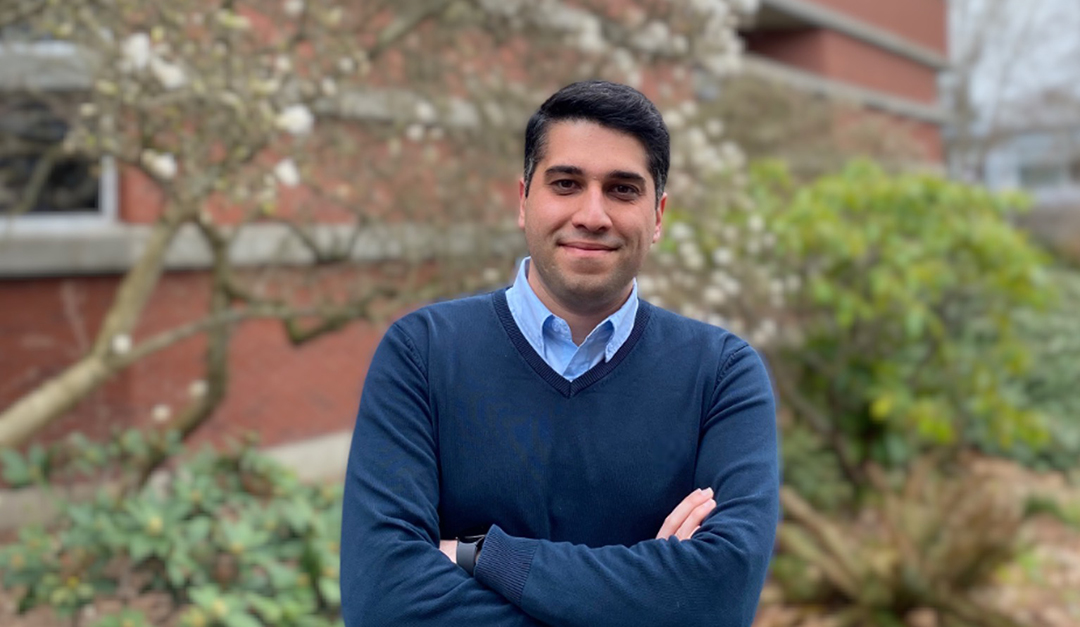by Pedram Pourasgari, PhD student. Photos submitted.
The stories I recently heard at the Community Resilience Workshop held at the Gustavson School of Business on May 25-28, 2023 were captivating. These stories were about communities displaying resilience, not just to survive but to thrive. In a panel discussion titled “Practitioner Perspectives on Building Resilient Communities,” a distinguished group of speakers shared their insights and experiences about their organizations’ contributions to fostering resilience within their communities. Amy Rowsell of Shorefast, Emilie de Rosenroll of the South Island Prosperity Partnership (SIPP), Joanie Cranston of the Bonne Bay Cottage Hospital Heritage Corporation and Christina Clarke of the Indigenous Prosperity Centre joined an enlightening session to bring a practitioner’s perspective to an academic event.
Researchers came from as far as Australia to exchange knowledge with each other and practitioners. Through the panel discussion and the practitioners’ exchanges with the researchers, I learned about community members and social entrepreneurs coming together on Fogo Island to revitalize their community after years of economic and population decline triggered by the collapse of the cod fishery in the later 20th century. I also heard about South Vancouver Island’s community actors uniting after a global economic downturn to transform despair into recovery and recovery into resilience. I was inspired by a community entrepreneur who dedicated her life to fostering resilience in Norris Point by preserving a cottage hospital that the community had built and repurposing it to promote health and wellness, as well as economic and social development. These stories reminded me of the profound impact that emerges when Indigenous knowledge and wisdom blend with innovation, paving the way for sustainable and long-lasting prosperity.
During my studies at the University of Victoria, I often meet students who started their academic journeys with a desire to achieve something meaningful out of the time and effort they invest in their studies. Their aspirations often transcend personal growth and include a commitment to their families, communities and the preservation of our planet. I am always inspired when I witness these aspirations coming to fruition.
As a PhD student hoping to make an impact through research, I found it extremely motivating to hear how these community practitioners leverage established academic models and frameworks to advance their initiatives. They highlighted the advantages of applying the PLACE framework of community development, which elaborates on five key activities that help social enterprises strengthen communities:
- Promote community leaders
- Link divergent perspectives
- Amplify local capacities
- Convey compelling stories
- Engage in “both/and” thinking
In particular, they spoke of the power of storytelling and the importance of “both/and” thinking in dealing with the tensions and paradoxes they face in their community development work. I was also intrigued to hear about practitioners’ efforts to develop their own frameworks, such as RISE, which emphasizes the necessity of building a Resilient, Innovative, Sustainable and Equitable economy.
The sharing of these experiences illuminates a path that exists between academic research and fostering sustainable community resilience—a path that we can follow to make our research have a meaningful impact. It also demonstrates the value that collaborations between academic institutions and practitioners can unleash. In the words of Joanie Cranston, “Working with academics helps me learn about models around the world and other ways of doing things.”
The desire of community entrepreneurs to learn about the experiences and practices of other communities around the globe reminds us of our collective  responsibility to actively take part in and contribute to global academic communities, ensuring the exchange of knowledge and ideas. Equally important is the proper communication of our learnings to local communities and key stakeholders, including policymakers. On the other hand, practitioners, with their hands-on experience, can provide unique perspectives that allow us to see their impact in novel ways that conventional approaches may fall short of capturing. As Emilie de Rosenroll pointed out, “In non-profit work, the impacts are very qualitative and [measuring them] is not as easy as in the private sector.”
responsibility to actively take part in and contribute to global academic communities, ensuring the exchange of knowledge and ideas. Equally important is the proper communication of our learnings to local communities and key stakeholders, including policymakers. On the other hand, practitioners, with their hands-on experience, can provide unique perspectives that allow us to see their impact in novel ways that conventional approaches may fall short of capturing. As Emilie de Rosenroll pointed out, “In non-profit work, the impacts are very qualitative and [measuring them] is not as easy as in the private sector.”
Regardless of how we measure them, these impactful practices have contributed to community resilience. At the heart of resilient communities are resilient people—individuals who care for their communities, actively take part in collaborative initiatives and share a strong sense of attachment to their place. As Amy Rowsell puts it, paraphrasing Shorefast’s mission, they can “harness the power of place to help local communities thrive.”
Indeed, communities are not all the same and they face different challenges that need distinct solutions. Yet, it is critical to learn from one another and recognize that the most fundamental elements contributing to community resilience are not about being part of a specific community but about being human. Two organizations represented in the panel (Shorefast and SIPP) participated in the Shorefast Community Economies Pilot, which examined communities of various sizes across Canada. The pilot provided insights on how to strengthen community economies by
- attracting and retaining financial capital
- creating architectures of collaboration
- accessing and leveraging data
- building local capacity
The stories we heard that day showcased the interconnectedness of community resilience narratives from both ends of Canada and their ability to inspire and support each other. I dream of a day when the same thing happens worldwide, connecting communities from all over the globe, especially as we confront challenges like climate change that necessitate innovations through cross-community collaboration and knowledge-sharing. Echoing Christina Clarke’s words, “At this time in our history as a species, we need that innovation desperately, and Indigenous ways of knowing and being in relation to the land could tell us that our prosperity is dependent on the health and well-being of the land.”


